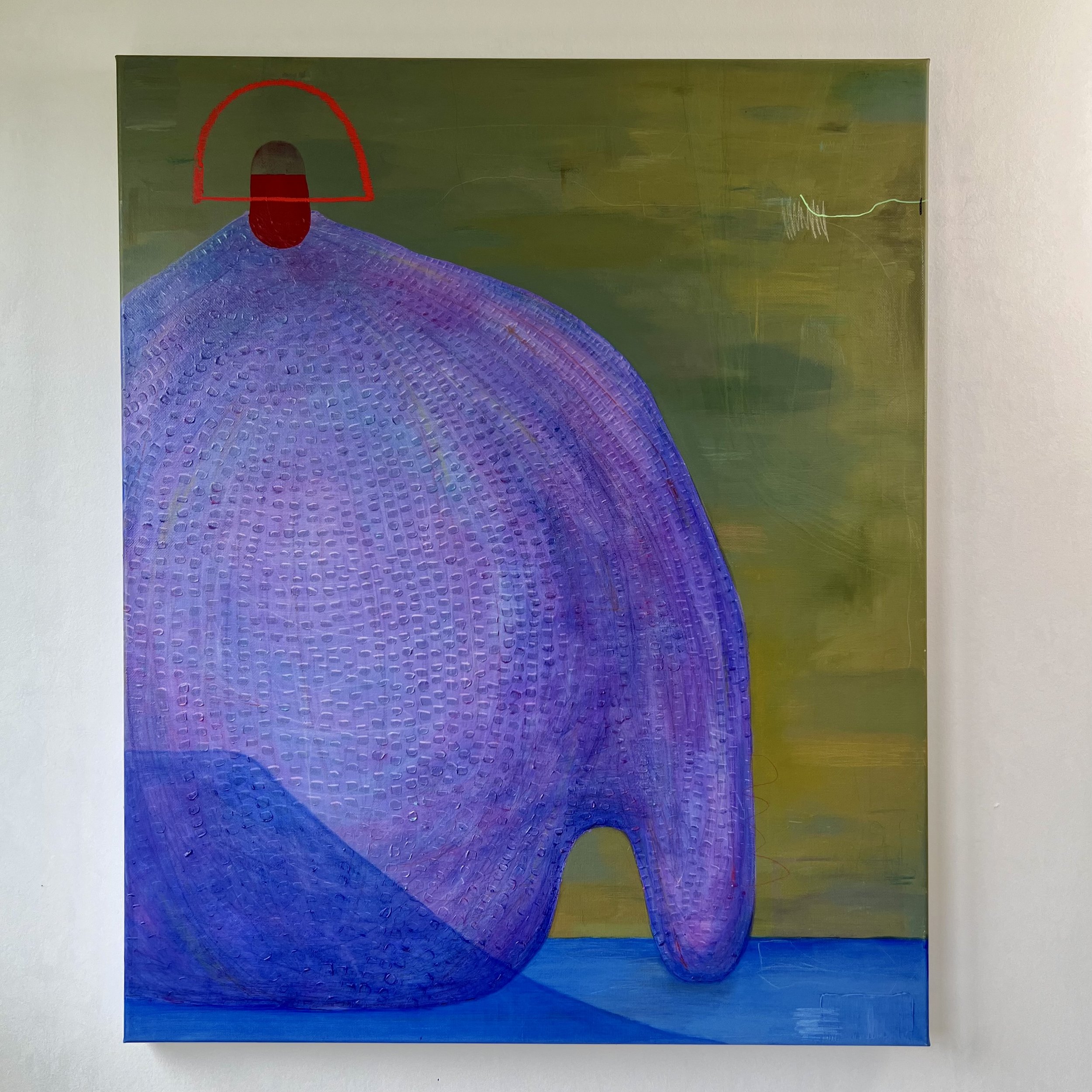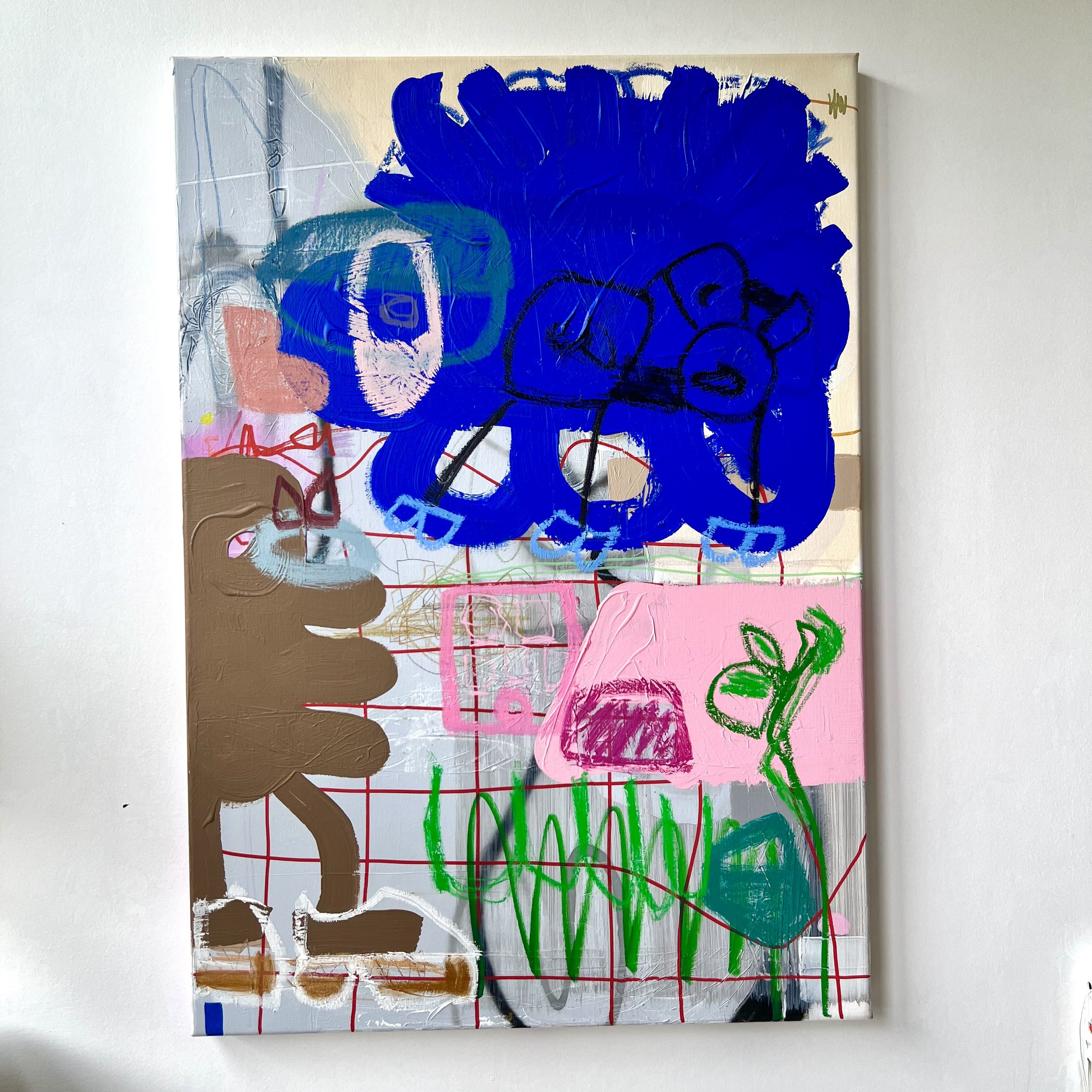An Interview With Camilla Näsholm
The central theme in Camilla's artistic practice is interconnectedness. She explores the relationships between monumental vastness and the meticulously small in painting and writing. Her practice is a proclamation of our relative nature as humans, how tiny we are amid an enormous landscape but massive next to subatomic particles. With her lifelong interest in the natural sciences Camilla is fascinated by the extraordinary intelligence the structures of life continue to display no matter how much we zoom in or out. How humans are an equal part of this, and how our seemingly inherent illusion of separateness influences our behaviour and the world.
Can you tell us a little bit about you?
I grew up in a small working-class town in the remote subarctic region of northern Sweden; I was far away from fine art institutions, and the general message I received during my upbringing was that art was something for wealthy people and served no greater purpose for society. Therefore, I never thought I could be an artist, but I started painting and drawing diligently at 11. By the time I had reached my 20s, there was no going back. I felt called to be a painter. It was never an active choice for me to become an artist; over time, it just proved necessary for my being. I am now 35, and even though I have been painting for more than 20 years, I just got started and still have my most artistically fruitful years ahead of me.
What is your artistic process and how has it evolved since you began painting?
As many artists do, I spent my first 10-15 years learning to control the outcome of my drawing and painting. I drew nicely and studied how to paint the physical world, anatomy, different materials, and so on. Quite quickly, I lost interest. Growing up, I loved photography, and I felt that if I wanted a picture of the physical world, I'd use my camera. What fascinated me with painting was its ability to move beyond what the eye can see. My artistic process has always had two sides: a physical studio practice and a contemplative writing practice. These sides feed into one another in both directions. When I first started painting as a young teenager, I was influenced by surrealism, cubism, and expressionism. Visually twisting reality aligned with my appreciation of poetry and metaphorical forms of expression. After studying Buddhism, art, and design for many years, I became more interested in minimal and abstract forms of expression. I work on 10-40 different paintings simultaneously. They look like independent pieces to the observer, but for me, they are various parts of the same chain. I experiment a lot with the notion of control and power when I'm painting by giving the painting itself agency to tell me what it needs. It is a practice of delving into the unexpected, uncontrollable, and chaotic while suspending my judgment. Above all, listening to the painting before me is my primary practice.
How do you explore the theme of 'interconnectedness' through your work?
Interconnectedness is an overarching theme I plug into from many different angles in my work. These angles often relate to metaphysical questions such as: What is the nature of reality? What are we? Why are we here? What is our place in the universe? What happens after death? Is time an illusion? Etc. Through studying Tibetan Buddhism and having an interest in science, I always return to interconnectedness and unfold new subgenres of questions that influence my work. For me, artmaking is a scientific endeavor that contributes to our understanding of the world, ourselves, and the cosmos as a whole.
How does your art reflect your own experiences and emotions?
My art is more like a distillation and filtration process of a larger creative force rather than something personal. I'm often surprised by what I have made, and I feel as much as a viewer of my art as others do. However, for these ideas to make it into the physical world, they filter through me, and questions I currently ponder and my background affect the paintings' visual qualities. My job is to interpret, translate, and stay as true as I can to the original idea hiding in my gut. The exciting thing about my art is not the final painting but the process from which it is born into this world. The final painting is the souvenir I bring back from formless and limitless landscapes of the mind. It is a token representing a place stranger than your craziest imagination yet as familiar as your childhood home.
What does 'Abstraction' mean to you?
To me, nothing is truly abstract; everything already exists on some level of reality, and even the most mundane situation or object can become highly abstracted simply by zooming in or out. I paint primarily abstractly because, through my art, I deal with the parts of reality that are generally unavailable to us through our human senses or conventional thinking. I have always been drawn to the invisible and mysterious, which makes me interested in the outward science of physics and the inward science of exploring consciousness. At the core lies metaphysical questions, and from these questions, threads wander off into unknown territory into which I venture. My paintings are the souvenirs I bring back from these expeditions.
How do you overcome challenges as an artist?
I keep painting. I keep turning the outside world off when I enter the studio. I encourage myself to be fearless and not look at my paintings from the outside but feel them in my gut. When things get tough in the studio, I remind myself of this: my time in this body is limited; one day, I will die, and I have no clue how long I have left. One hundred years from now, nobody will remember me or anything I've done, so relax, god dammit, don't take things so seriously, have fun, and get to work.
What inspired you to start creating?
Like most kids, I enjoyed drawing as a kid, but instead of slowly stopping, the older I got, the more I did it. Eventually, I was drawing obsessively all the time. In my school books, on my school benches (which actually caused me several detentions), on walls, on my arms and legs—you get the picture. A formative memory I have is when I was in third grade: we were asked to paint a face, put it on the wall, and present our painting. When I saw everyone's paintings next to my own, I realized for the first time how differently I approached making images. To my big surprise, everyone had painted a typically arranged face, and only I had re-arranged everything on the face so nothing was in its usual place and no colors matched reality. The teacher was not pleased and wanted me to make a "serious one," but I told them this one was serious, and I refused to make a new one. Ultimately, being an artist is not entirely voluntary for me; not creating is not an option. I have too much creativity and ideas inside of me; they must come out.
Are there any particular artists that you are currently enjoying?
I recently saw an exhibition by Elias Crespin that stuck with me. He makes carefully choreographed moving sculptures/installations of repeated minimal shapes. I'm also enjoying looking at brutalist architecture from around the world.
What is your favourite book or film and why?
This is definitely the most challenging question to answer, but I will give you some answers. I've always been very interested in the future or the potential different futures that lie ahead of us, so In terms of movies, I enjoy GOOD sci-fi movies, for example, Her, Inception, Dune, the series Severance, 3 Body Problem, etc. They must be smart, without too much violence and horror, and more focused on exploring concepts and potential technologies. In terms of books, I keep reading this one book over and over again, so it must be my favorite: Insight-Emptiness by Khensur Jampa Tegchok. Another definitive favorite is Tao Te Ching by Lao Tzu (The one translated by Stephen mitchell)
Are you working on any projects you are particularly excited about?
I don't define my work as different projects; it's more like a river of infinite potential that I jump into every time I work in the studio. I try to get as many ideas up from that river as possible and try my best to stay true to those ideas while manifesting them as a painting. That being said, I am currently finalizing a group of large paintings that belong to 3 different series that I will be sharing soon, and in the autumn, I will begin a large group of smaller framed canvas paintings.









